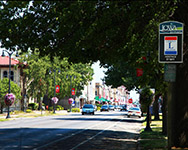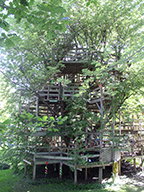Marshall
Marshall County
The soil in the county is a deep rich, black, alluvial loam with a small mixture of sand and is free from gravel or stone. This soil is good for the growth of all cereals, vegetables, and grasses. Early settlers were sparse and some of the earliest in 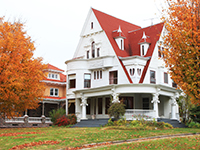 Marshall County were Mormons that came in the winter of 1846-47. They had been run out of Nauvoo, IL and travelled to the Marshall County area just as a brutal winter settled in. Many of them died here and were buried. In the spring, the remaining group was taken to Iowa City to regain their health before they travelled to Council Bluffs. Most of the Mormons in the Council Bluffs area eventually travelled by foot to their new home in Salt Lake City, UT.
Marshall County were Mormons that came in the winter of 1846-47. They had been run out of Nauvoo, IL and travelled to the Marshall County area just as a brutal winter settled in. Many of them died here and were buried. In the spring, the remaining group was taken to Iowa City to regain their health before they travelled to Council Bluffs. Most of the Mormons in the Council Bluffs area eventually travelled by foot to their new home in Salt Lake City, UT.
In 1850, white settlers in Marshall County ruined the nearby Indian crops and war dances commenced. As the settlers feared for their safety, it was suggested a fort be built and Fort Robinson was constructed. It was 90 feet square and 10 feet high and 24 families were taken in. They brought their bedding, furniture, and provisions. Cattle were left outside the walls and their crops in the hands of the Meskwakis. The war dances continued, but some settler men did engage the Indians in conversation, asking to see their weapons. Both sides were afraid of each other and eventually the Indians agreed to go to Missouri like the government wanted them to in exchange for flour, pork, ammo, and blankets.
The first town in Marshall County, LeGrand, built its first store in 1850. In 1851, the county was named for John Marshall, the fourth Chief Justice of the U.S. Supreme Court and the town of Marietta was chosen as the county seat.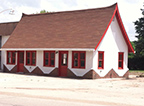
At the same time Marietta was being selected as the county seat, the town of Marshall was being formed. Each town worked with different railroad lines to help their communities grow. The battle ensued between the towns as to who should rightfully be the county seat. Many clashes between the residents occurred and some even included pelting eggs and vegetables at each other and muddy water shot out of a large sausage gun. Dynamite was placed in the courthouse in Marietta so it could be used to destroy the records instead of them falling into the hands of Marshall residents. The Browden Guards (militia) was called in to quell the fighting. Not until 1859, when the Iowa Supreme Court ruled the county seat be moved to Marshall, did the fighting stop. The residents of Marshall had already built a courthouse with no cost to the county. In 1863, the name Marshall was changed to Marshalltown to avoid confusion with Marshall in Henry County.
A third courthouse was built in 1886 from the limestone found in Marshall County. In 1973, it was listed on the National Register of Historic Places and the Friends of Courthouse Committee wanted to restore it. The referendum passed 5,399 to 3,550.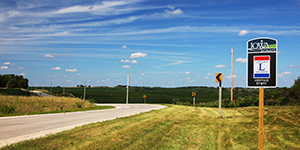
Marshall County and the Lincoln Highway
Henry B. Joy, the President of the Packard Car Company, travelled the Lincoln Highway in 1915 and got stuck in the mud outside of Lamoille in Marshall County, Iowa. There is a famous picture of him in his Packard stuck in the “gumbo”. The picture is in the Lincoln Highway Association Archive, Transportation History Collection, in the Special Collections Library at the University of Michigan.
The Lincoln Highway had as many as four routes through State Center. One route went to the north of town, one down Main Street and yet another on the south side of town.
Towns on the Lincoln Highway
The town was named for LeGrand Boyington of Iowa City who owned and platted the town. Iowa marble can be found at the quarry near here. Joseph Davidson, in 1847, was the first settler to the area and lived in a little cabin with the Indians nearby. A white neighbor was not to be seen for at least 50 miles. By 1853, a post office and the first store were built. The building lumber had to be hauled from Iowa City. Previously, residents had to go to Marengo to get their mail. The Chicago Northwestern Railroad came through in 1862-63. In 1873, a grade school called the Friend’s Academy was built. The Christian Institute was built in the 1960’s and a boarding house for students built in 1878.
Marshalltown
Henry Anson was the first settler to the area. The town of Marietta had already been named the county seat and they had hopes that someday, Marietta would also be the Iowa State Capitol. Congress, through public land grants, helped begin the Iowa Central Air Line Railroad in Marietta. Anson had started his town of Marshall and named it after Chief Justice John Marshall who served from 1755-1835. The towns of Marshall and Marietta had many conflicts over who should be the county seat. Marshall worked with Cedar Rapids and asked the Iowa Legislature to transfer the franchise of Airline to the Chicago, Iowa and Nebraska Railroad. This made Marshall the railroad town in the county and killed Marietta and the Airline Railroad.
In 1862, the first rail ran into town and it was pushed west quickly. By 1867, it was completed to Council Bluffs. The speed of laying the line was encouraged as the Union Pacific would donate $75,000 if it was completed in 1867. This was the first railroad to be built across Iowa and to the Missouri River. Other rail lines came through town- the Eldora Railroad and Coal Company and the Chicago Northwestern operating as the Cedar Rapids and Missouri River Railroad that carried on as the Iowa River Railway.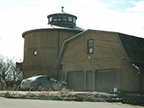
Today’s points of interest include the 1917 Greek Revival -style City Hall, the 1884 Marshall County Court House (renovated in 1970 and on the National Register of Historic Places), the 1910 Willard Mansion, the 1874 Italinate-styl e Binford House, and the Glick-Sower at 2nd and E State (on the National Register of Historic Places).
The Fisher Theater is home to the Marshalltown Community Theater and offers a full season of plays. The Fisher Community Center houses the Fisher Art Gallery, Chamber office, and community nursing services. There is also a Vietnam-era F-4C Phantom on display at the American Legion Grounds, an Elk’s Club Monument at Riverside Cemetery, sculptures of bronzes in the pond at the Fisher Community Center, and a log cabin at Riverview Park. Visitors can also check out the bike trails and the aquatic center. www.ci.marshalltown.ia.us https://archive.org/details/historyofmarshal00west
To the east of Marshalltown, along the Lincoln Highway, is Shady Oaks, the oldest private campground. It was originally called Rock Valley and nearby is the Rock Valley Cemetery. Shady Oaks was begun in 1850 and the stand of bur oak trees there was named by the Iowa DNR to the register of “Famous Historic Trees”. Shady Oaks has RV parking, tent sites, and shower and bathrooms. A cabin built in 1925, in the heyday of the Lincoln Highway, has been restored. In 1983, the Big Tree House was built. It has 12 levels, 55 foot high and the tree house has over 5,000 square feet of floor space. It is complete with music, electricity, phone, microwave, fridge, running water, grill, 13 porch swings, spiral stairway, and much more. www.bigtreehouse.net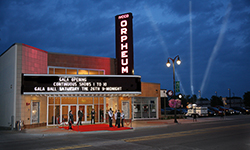
Jean Seberg, an actress, was born in 1938 in Marshalltown. She appeared in stock theater and plays on the East coast. She had planned on attending the University of Iowa, then go to Broadway, and then into films. Her education plans went awry when in 1956, director Otto Preminger chose her out of 18,000 aspiring actresses to star in the movie “St. Joan”. She became an instant star. As she had a command of 4 languages, she appeared in many foreign films and was known as the “Darling of Paris”. Jean was in “Paint Your Wagon” in 1969 and used her earnings on social issues. This raised the interest of the FBI into her life. After winning a court case over lies printed in Newsweek, she gave birth to a premature baby, Nina. The baby lived 2 days and may have led to Jean’s depression and mysterious death, still unsolved.
Lamoille
Isaac B. Howe named the town for the LaMoille River in Vermont, where his friend J.L. Stevens lived along the banks of that stream. This is an unincorporated town and was an outgrowth of the Chicago and Northwestern Railway. The railroad surveyed it in 1863 and built a depot. The village was platted in 1867. Henry B. Joy, the President of the Packard Car Company, travelled the Lincoln Highway in 1915 on a coast-to-coast trip and got stuck in the mud near this town. A very famous photograph was taken of Mr. Joy, his Packard, and the Iowa mud.
State Center
The railroad first called this town Centre Station and the first agent to work here changed it to State Center as it is near the geographic center of the state. In 1861, the Cedar Rapids and Missouri Railroad surveyed their line. In 1863, the Chicago and Northwestern Railroad laid its tracks. There was a daily stage from State Center to Des Moines. The first house was moved from Marietta in 1863 and was used as a hotel. The Post office was established in 1864.
Today, the town is known as “The Rose Capitol of Iowa” and holds a Rose Festival every June complete with a parade, crowning of a Rose Queen, and many other fun events. Other sites to see are the State Center Rose Garden, Kauffman Park (built in 1923 to serve the Lincoln Highway travelers), the Veterans Memorial, and the Lincoln Highway Golf Course and Clubhouse. A three block area of the downtown is on the National Register of Historic Places and includes Watson’s Grocery Store (a museum), Benson Building (restored and home of NuCara Pharmacy) and Sheppler Barbershop Museum. A 1932 Home Oil Gas Station, which sits along the 1931-1963 route of the Lincoln Highway has been renovated and is now the home of the State Center Police Department.
Over the years, the Lincoln Highway took 4 different routes through State Center. www.statecenteriowa.org
Other Towns in Marshall County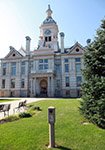
Albion
First called Lafayette, the town name was changed to 1858 to Albion which means “whiteness” and “land” which was a name often used by English poetic writers.
Bangor
In 1850, a group of Friends (Quakers) left North Carolina and travelled by horse and covered wagons in search of a place where they could worship as they chose and to get away from the slave trade as they could not conscientiously uphold it. The found a location they sought in Marshall County and the town of Bangor was laid out in 1854. The Friends built the first church in Bangor. By 1860, they held the largest Friend meeting in the world. Several of the residents helped with the Underground Railroad, but it is not known how many people they helped. Detailed records were not kept for safety reasons. One family, the Warrens, stayed in Bangor. Two of them lived to be 109 and 116 years old and were buried in the local cemetery. The town today remains unincorporated.
Clemons
The town of Clemons was founded in 1882 by the Clemons family and was first called Clemons Grove.
Dunbar
Dunbar was platted in 1882 and remains unincorporated. It was established by the Milwaukee, St. Paul and Pacific railroad and named for the landowners.
Ferguson
The town was established in 1882 by the Chicago, Milwaukee, St Paul and Pacific Railroad and was named for early settlers to the area.
Gilman
In 1870, the town was laid out by the Town Lot Company after the residents gave $10,000 and 10 acres of land to the Iowa Central Railroad to run through Gilman. It was named for Mr. Gilman, who was involved with the Iowa Central.
Green Mountain
The town was established in 1883 and remains unincorporated. It was named in honor of the state of Vermont, the Green Mountain state, where the early settlers came from. It was platted by the Iowa Construction Company.
In 1910, the worst train wreck ever in Iowa history occurred here. The Chicago and Great Western accident killed 52 people.
Haverhill
The Milwaukee Land Company established the town in 1882. It is said to be named after Haverhill in Suffolk, England. The name is thought to mean “hill where the oats are grown” as “haver” is a British term for oats.
A German immigrant started a blacksmith shop here in 1882 and continued on until his death in 1940. He not only shoed horses, but repaired implements. Today, the Edel Black Smith Shop is owned by the State Historical Society of Iowa, listed on the National Register of Historic Places and is operated as a museum. The shop is just as Mr. Edel left it. Located at 241 1st St, you can find more information at www.iowahistory.org/historic-sites/edel-blacksmith-shop/index.html or call 641-752-6664.
Laurel
Conrad Wissenbarger platted the town in 1880 and it was incorporated in 1902.
Liscomb
The first settlers arrived in 1850-51. In 1857, farmers hauled their grain to Margeno to sell it. The Central Railroad of Iowa came through in 1869 the town was laid out. In 1875, the Farmers Union Railroad formed to build a narrow gauge rail line to the Mississippi River from Liscomb. Ten miles of wooden track was laid and twenty miles graded. They purchased an engine and 10 cars in Cincinnati and ran the road for 6 months before it fell into litigation. The town was named for H.P. Liscomb, the promoter and builder of the Iowa Central Railroad.
Melbourne
The town was to be called Wenselville after W.L.M. Wensel, the landowner. He declined the honor and named it after an employee of the Great Western Railroad. The town is located at the crossing of the Chicago Great Western and the Chicago, Milwaukee, and St. Paul Railroads. It was platted in 1882 by the Milwaukee Land Company.
Quarry
This town remains unincorporated and was named for a nearby quarry by Isaac B. Howe who laid the town out in 1868 for the Chicago and Northwestern Railroad. In 1869, the residents built a brick two-room school house.
Rhodes
Rhodes was first called Edenville when laid out in 1856, but the name changed to honor C.B. Rhodes, a landholder and leader in the town’s early history. Today, Harvestor Golf Course, an 800-acre site with natural landscape features is complete with a restaurant, golf shop, and golf lessons. Check it out at 833 Foster Drive or www.harvestorgolf.com ; phone 641-227-4653.
St. Anthony
It was named and platted by A.J. Mabie, James Q. Saint, and Anthony Pierce and is a combination of their names. Today, stop by Flatheads Bar and Grill at 104 W 3rd St, phone 641-477-8100.

